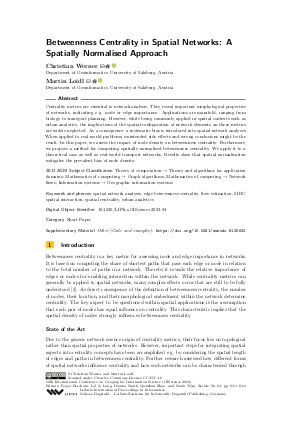Betweenness Centrality in Spatial Networks: A Spatially Normalised Approach (Short Paper)
Authors
Christian Werner  ,
Martin Loidl
,
Martin Loidl 
-
Part of:
Volume:
12th International Conference on Geographic Information Science (GIScience 2023)
Part of: Series: Leibniz International Proceedings in Informatics (LIPIcs)
Part of: Conference: International Conference on Geographic Information Science (GIScience) - License:
 Creative Commons Attribution 4.0 International license
Creative Commons Attribution 4.0 International license
- Publication Date: 2023-09-07
File

PDF
LIPIcs.GIScience.2023.83.pdf
- Filesize: 0.83 MB
- 6 pages
Document Identifiers
Subject Classification
ACM Subject Classification
- Theory of computation → Theory and algorithms for application domains
- Mathematics of computing → Graph algorithms
- Mathematics of computing → Network flows
- Information systems → Geographic information systems
Keywords
- spatial network analysis
- edge betweenness centrality
- flow estimation
- SIBC
- spatial interaction
- spatial centrality
- urban analytics
Metrics
- Access Statistics
-
Total Accesses (updated on a weekly basis)
0PDF Downloads0Metadata Views
Abstract
Centrality metrics are essential to network analysis. They reveal important morphological properties of networks, indicating e.g. node or edge importance. Applications are manifold, ranging from biology to transport planning. However, while being commonly applied in spatial contexts such as urban analytics, the implications of the spatial configuration of network elements on these metrics are widely neglected. As a consequence, a systematic bias is introduced into spatial network analyses. When applied to real-world problems, unintended side effects and wrong conclusions might be the result. In this paper, we assess the impact of node density on betweenness centrality. Furthermore, we propose a method for computing spatially normalised betweenness centrality. We apply it to a theoretical case as well as real-world transport networks. Results show that spatial normalisation mitigates the prevalent bias of node density.
Cite As Get BibTex
Christian Werner and Martin Loidl. Betweenness Centrality in Spatial Networks: A Spatially Normalised Approach (Short Paper). In 12th International Conference on Geographic Information Science (GIScience 2023). Leibniz International Proceedings in Informatics (LIPIcs), Volume 277, pp. 83:1-83:6, Schloss Dagstuhl – Leibniz-Zentrum für Informatik (2023)
https://doi.org/10.4230/LIPIcs.GIScience.2023.83
BibTex
@InProceedings{werner_et_al:LIPIcs.GIScience.2023.83,
author = {Werner, Christian and Loidl, Martin},
title = {{Betweenness Centrality in Spatial Networks: A Spatially Normalised Approach}},
booktitle = {12th International Conference on Geographic Information Science (GIScience 2023)},
pages = {83:1--83:6},
series = {Leibniz International Proceedings in Informatics (LIPIcs)},
ISBN = {978-3-95977-288-4},
ISSN = {1868-8969},
year = {2023},
volume = {277},
editor = {Beecham, Roger and Long, Jed A. and Smith, Dianna and Zhao, Qunshan and Wise, Sarah},
publisher = {Schloss Dagstuhl -- Leibniz-Zentrum f{\"u}r Informatik},
address = {Dagstuhl, Germany},
URL = {https://drops.dagstuhl.de/entities/document/10.4230/LIPIcs.GIScience.2023.83},
URN = {urn:nbn:de:0030-drops-189781},
doi = {10.4230/LIPIcs.GIScience.2023.83},
annote = {Keywords: spatial network analysis, edge betweenness centrality, flow estimation, SIBC, spatial interaction, spatial centrality, urban analytics}
}
Author Details
Supplementary Materials
- Other (Code and examples) https://doi.org/10.5281/zenodo.8125632
References
- Alessandro Araldi and Giovanni Fusco. From the street to the metropolitan region: Pedestrian perspective in urban fabric analysis. Environment and Planning B: Urban Analytics and City Science, 46(7):1243-1263, September 2019. URL: https://doi.org/10.1177/2399808319832612.
- Marc Barthelemy. Morphogenesis of Spatial Networks. Lecture Notes in Morphogenesis. Springer International Publishing, Cham, 2018. URL: https://doi.org/10.1007/978-3-319-20565-6.
- Ulrik Brandes. A faster algorithm for betweenness centrality. The Journal of Mathematical Sociology, 25(2):163-177, June 2001. URL: https://doi.org/10.1080/0022250X.2001.9990249.
- L. da F. Costa, B. A. N. Travençolo, M. P. Viana, and E. Strano. On the efficiency of transportation systems in large cities. Europhysics Letters, 91(1):18003, July 2010. URL: https://doi.org/10.1209/0295-5075/91/18003.
- Stefan Lämmer, Björn Gehlsen, and Dirk Helbing. Scaling laws in the spatial structure of urban road networks. Physica A: Statistical Mechanics and its Applications, 363(1):89-95, April 2006. URL: https://doi.org/10.1016/j.physa.2006.01.051.
- Parongama Sen, Subinay Dasgupta, Arnab Chatterjee, P. A. Sreeram, G. Mukherjee, and S. S. Manna. Small-world properties of the Indian railway network. Physical Review E, 67(3):036106, March 2003. URL: https://doi.org/10.1103/PhysRevE.67.036106.
- Xiaohuan Wu, Wenpu Cao, Jianying Wang, Yi Zhang, Weijun Yang, and Yu Liu. A spatial interaction incorporated betweenness centrality measure. PLOS ONE, 17(5):e0268203, May 2022. URL: https://doi.org/10.1371/journal.pone.0268203.
